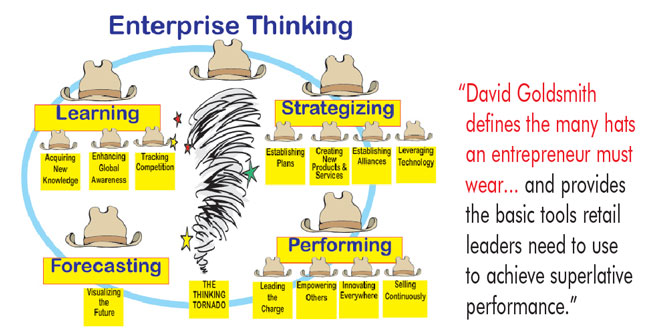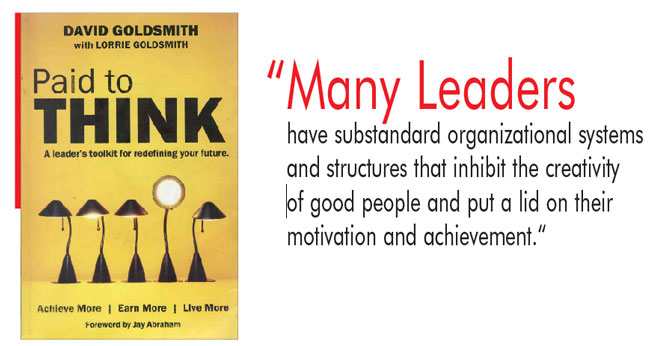Each week I have the privilege of talking with one or two furniture entrepreneurs. What I admire most about these accomplished individuals is how they manage to wear so many hats. They are required to be visionaries as well as pragmatists. They must be managers, buyers, display experts, sales managers, public relations experts, marketing geniuses, psychologists, operations experts, and on and on.
Not all home furnishings entrepreneurs are equal.
Very few furniture retailers are playing chess, while the vast majority are playing checkers. It is not due to a lack of intelligence. Many brilliant merchants run stores that are performing well below their potentials. Nor are these performance issues related to the size of their businesses. Big Box franchises usually operate in corporate silos and are leaving a great deal on the table. So, what is missing?

We all learned many things in school and in life, but the vast majority of business owners were never taught HOW to think. Most of us, therefore, lack a “kit of tools” to easily manage and solve our everyday problems. In his 700 page opus, “Paid to Think”, David Goldsmith states that too many decision makers are still trying to drive their companies at 200 mph using the skills, knowledge and tools of a 65 mph driver. In Paid to Think… A Leader’s Toolkit for Defining Your Future, Goldsmith explains what you need to do to become a world-class thinker, and suggests the tools needed to achieve this goal. That is, if you are interested in playing chess instead of checkers. Jay Abraham (who wrote the foreword to Goldsmith’s book) says of it: “What Peter Drucker did for current management theory and practice, David Goldsmith has done for modern-day leadership in Paid to Think.”
Thinking is the key to superlative leadership. I probably would not be writing this article if Goldsmith was not a man of action as well as a thinker. When David’s book arrived from Amazon I realized it would be challenging to review in depth. After several hours of reading, I did recognize the book’s profundity and value, so I gave it a brief but laudatory review. To my surprise I got an immediate “Thank You” email from David. This inspired me to engage the book with greater thoroughness and write a more comprehensive, but admittedly still incomplete, review of Paid to Think. A few days later I got a telephone call from David! It was an engaging, if brief, conversation. I became a fan.
Want prospects who become lifetime customers? Treat them as though they are valued as clients. Call them personally to see if they are pleased with their purchase. Impossible? Before you give up on this article, please read the following true story. I have told it before, but it is worth retelling. Lifetime customers are worth their weight in gold. This story tells how one furniture entrepreneur acquires a few lifetime customers each week.
Hello Mrs. Smith
A year or so ago I entered into the office of the owner of one of the more successful furniture franchises in America. Paul requested that I sit down. He had a couple of calls to make before he could spend time with me planning a furniture promotion. I had worked with Paul Barbaro for several years, but I was about to learn about the secret sauce that, more than any other factor, had lifted him to world class franchise status. What I heard in his phone conversation in those brief moments astounded me:
“Hello, Mrs. Smith. My name is Paul Barbaro. I am the owner of the Slumberland store here in Willmar. Is this a good time for you? I am calling because I see you made a purchase of a living room group at our store. I want to check to see if you were pleased with your shopping experience with us ... Good, I am delighted that you love your new furnishings ... I have just one more question. On a scale of one to ten, how likely would you be to recommend Slumberland to your friends and neighbors?”

That is about the gist of Paul’s message to his clients. Do not underestimate the power of this message to add value to the shopping experience. Britt Beemer has made the point that people are honored when the owner of a store engages them in a meaningful conversation. And the worth of a customer over a lifetime cannot be exaggerated. In addition, Paul asks indirectly but clearly for the likelihood of a testimonial. There is absolutely no more powerful marketing than word of mouth from a trusted friend. The basic principles of marketing are still valid, but capturing the attention of prospects is becoming more and more difficult. The internet, social media, relationship selling, and word of mouth recommendations are all part of the media mix now. Ignore these activities at your own peril.
Something To Hold
Turning prospects into customers on the first visit has never been more difficult. Prospects are more educated, web and social media savvy, and cautious. This is especially true of better stores. Jeff Cohen noticed in his higher end leather furniture store in St. Augustine that, contrary to conventional wisdom, prospects bought on the first visit only 15% or 20% of the time. However, it is not uncommon for his prospects to return three or four times (or even more) before they buy. Jeff discovered early on that giving a prospect something to carry out of the store would greatly increase the likelihood of a return visit. At first he relied upon a leather sample or a factory brochure. Then he discovered that a custom three-fold handout was much more effective. (See the exhibit above.) The idea is to create a best-selling story about your store; commit it to print and make sure each prospect leaves the store with your “silent sales consultant” in their hand. Operations Manager Steve Lent (who works the floor when needed) says: “Our first task is to show sincere interest in the customer. Relationship is a key ingredient to serving effectively. When we moved to our new location, many old customers dropped in just to say ‘hello’ and congratulate us on our success. These friendships and connections are precious.”
We need thinkers, innovators and doers
The furniture industry needs mature, thinking leaders today as never before. The demands on retail leaders are more stressful than they have ever been. David Goldsmith tells us that his ET system (Enterprise Thinking) will transform your entire organization into an “unsiloed,” smooth-operating reality. Unsiloed is the operative word. Just as I.T. pros use technology to integrate all the activities of an organization to achieve better outcomes, Enterprise Thinking uses a new mental arsenal to achieve the same thing. This is possible because all four activities of ET and their companion tools make for better outcomes. (See exhibit on page 48.)
If this appears complicated, remember you are already wearing all four hats now. You are already a Learner, a Strategist, a Forecaster and a Performer. But you are most likely still playing checkers. David will show you how to play chess. Enterprise Thinking is a turbo-charged way of getting your organization up to speed fast. The exhibit in this article shows how the four essential hats break down into twelve activities. Of course, the retail mind does not work in a linear, insulated way. It swirls like a cyclone and darts from activity to activity. David recognizes this, and incorporates this core creative chaos as part of his ET process. Unfortunately, too often furniture entrepreneurs zap around from decision to decision, with too little time spent on thinking about the decision before committing to it.
Don’t have time to just
think? Here is how to do it
As a specialist in marketing, I have a simpler set of tasks than you. But I also need time to think, and to learn. Innovative ideas are born from isolated thinking time without interruption. As Goldsmith noted, Henry Ford once said: “Thinking is the hardest work there is, which is probably the reason so few engage in it.” Over the years I have developed my own system of daily planning, and very likely you have too. But David has added important ingredients to planning.
For example, you know the traditional drill… set your to-do list, time-frame activities, set priorities, and go for it! Priorities are critically important. You are also aware of the Pareto Principle: “80% of output comes from 20% of input, not only in the business world, but also in virtually every aspect of life.” [Richard Koch] In retail we learn that 80% of the sales come from 20% of the sales people. 80% of the profit comes from 20% of the floor. And on and on. Goldsmith buys into the Pareto idea.

But, it is not surprising that David Goldsmith would have a new spin on this idea. He calls it the GPP, or Goldsmith Productivity Principle: “80% of an organization’s ability to compete and perform is driven by its systems and structures, and only 20% by its people.” You may wonder what happened to the concept that our most valuable asset is our people. Setting aside the exact hypothetical percentage, David persuasively suggests that many leaders have substandard organizational systems and structures that inhibit the creativity of good people and put a lid on their motivation and achievement. Potential chess playing entrepreneurs get the idea of the importance of systems and structures immediately and start seeing GPP everywhere… “at work, at home, during civic and religious services, at social events” etc. David’s point is that great associates emerge from good systems, and could be repressed by weak ones.
Goldsmith also reminds us of an often neglected supplement to the planning process that has helped me considerably: Plan your day the night before. It only takes 20 minutes or so at first, and later half that. And, as David says, “every second is worth it.” Even so, for maximum benefit do this at the end of the day, and in a place where you can have complete, uninterrupted privacy. You will actually sleep better and be prepared to hit the ground running in the morning with increasing clarity and confidence.
Rethink your assumptions
Goldsmith will challenge many assumptions that you may have accepted, and he suggests that you revisit. If you are willing to learn, his book will, without question, make you a more effective leader and manager. Stop right there and consider a key assumption as to whether your role is mostly leading or managing. In these modern times, if you are a key decision maker, you are most likely both a manager and a leader. But even the smartest person in the room sometimes has assumptions about these roles that encumber his or her performance. You will elevate your game when you appropriately combine the best features of leading and managing.
For example, many modern executives consider themselves purely leaders, and imagine that they are exclusively responsible for corporate strategy. Once a strategy is decided upon, they retire to their offices and leave the execution to managers. This lack of direct involvement and follow-through can be fatal to the effectiveness of a business. Consider if a modern professional football coach operated this way. The great coaches in the NFL develop a strategic game plan, and then follow-through in the game with hands-on tactical execution in concert with their middle managers. They know the ultimate game plan can go out the window if the quarterback or another key player is hurt. Emergencies come up constantly and must be handled. So, they both lead and manage. You must do this as well. The Japanese call this “Gemba” or workplace management. Go to https://www.furninfo.com/Authors/Larry%20Mullins/9 and check out the three-part series, “Management by Walking Around Revisited.”
Teach others to THINK
Without question, America is in dire need of new leaders. For most furniture stores, most leaders are created through on the job training. You likely believe you are getting fewer and fewer applicants who are qualified for leadership. Goldsmith suggests that teaching by example is important, but consider that instructing how you think is of even greater importance. Associates observe your decisions, but they are not usually privy to how you arrived at them. Sometimes what appeared to be a snap decision was really one that took weeks, if not months, perhaps years of consideration. If you fail to explain the rationale behind what you do, the future generation of leaders will come to the mistaken conclusion that leadership is mastering the art of making quick spontaneous decisions. In reality, good executive decisions are born of patient thinking.
Before you decide that there is no adequate training material available for leadership, consider the military. Years ago the late Peter Drucker, the father of modern management, and Jack Welch, the notable CEO of GE, agreed the United States Military did the best job of training leaders. Even today, a weakened military has performed virtual miracles in the past few years. They do it by the consistent, patient efforts of the collective leadership in uniform. The military still has a colossal job. The ranks of the military come from volunteers. Leaders must be developed from within. The military can’t hire a headhunter to find a new General. For more information on how they take ordinary volunteers and teach them leadership, go to
https://www.furninfo.com/Authors/Larry%20Mullins/9 and check out the three-part series, “Every Associate A Leader”.
The take home message from David Goldsmith’s book embraces a way to empower yourself to live your best life. David does not insist that you need to master all the hats you have to wear to see important changes for your organization and your life. Just remember you are paid to think. Try to rope out 30 uninterrupted minutes a day devoted purely to thinking. In a year that will equal over three solid 40-hour weeks of uninterrupted thinking. “Now is the time to build your tomorrow,” says David. And he follows through with game-changing advice.
Larry Mullins is a contributing editor for Furniture World and has 30+ years of experience on the front lines of furniture marketing. Larry’s mainstream executive experience, his creative work with promotion specialists, and mastery of advertising principles have established him as one of the foremost experts in furniture marketing. His affordable High-Impact programs produce legendary results for everything from cash raising events to profitable exit strategies. His newest books, THE METAVALUES BREAKTHROUGH and IMMATURE PEOPLE WITH POWER… How to Handle Them have recently been released by Morgan James Publishing. Joe Girard, “The World’s Greatest Salesman” said of this book: “If I had read Larry Mullins’ book when I started out, I would have reached the top much sooner than I did.” Larry is founder and CEO of UltraSales, Inc. and can be reached directly at 904.794.9212 or at Larrym@furninfo.com. See more articles by Larry at www.furninfo.com or www.ultrasales.com.